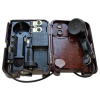NO FUCKING WAY, BLYAT!
The 35th army of RF AF, fighting in the forests near Izyum – they asked me to convey a message that, generally speaking, the task of destroying own forces was successfully completed by army’s command – the army is almost gone. To celebrate this event, the army received KAMAZ trucks loaded with shoe polish and toilet paper. The toilet paper, having travelled half the way under pouring rain in trucks with leaky roofs, of course, has fully soaked and without drying it is unsuitable for use (the question of large-scale hanging of the toilet paper to dry is being agreed with the command right now).
The task of destroying own troops was made easier for the command of the 35th army by the fact that, first of all, the army transferred from Far East, without the elements attached to it later, initially represented an incomplete corps with just two full motorised brigades forming the main strike force, and secondly, the forces were driven into the woods to fight the enemy, generally reproducing the conditions of the Hürtgen forest meat grinder of autumn-winter 1944 in the Western front of the Second World War, where the Germans managed for a while to successfully hold off the advance of the allies using only partially combat-ready units, using the terrain, strongpoints and a well-functioning fire system, primarily artillery.
The command of the army only needed to ensure that the forces would not get the necessary means to create various field fortifications and shelters. In forest conditions, when a major part of the enemy missiles and bombs explode at the top of the trees showering everything with shrapnel, this in general solves the question of destroying the personnel and light armoured vehicles, half of which at the moment are non-functional for technical reasons, and another half – due to damage from said shrapnel.
The army command succeeded with this task. From tools for mechanisation and fortification construction, the whole army had around 20 trench charges capable of somewhat increasing the speed of constructing one platoon-level strongpoint. There were not enough BSL-110 spades, picks were missing completely. The lack of spades for construction of at least some form of shelters was compensated by buying up spades from all around the area. At the same time the vehicles parked without shelters for which there were not tools to dig them out, were methodically being destroyed by the enemy.
Since the army did not have any volunteers capable of promptly purchasing and delivering at least some civilian communication equipment, the communications during the main period of hostilities were provided in the first line of battle formation by, at best, field phones TA-57, but for the most part – by messengers.
The enemy however, equipped with modern communication tools and using UAVs freely and on a large-scale, including commercial drones, had an opportunity to deliver substantial blows to our troops taking minimal effort to do so during the hostilities.
Thus, by early June the numbers of combat-ready infantry in certain motorised brigade battalions of the army successfully reached 12-15 people (64th brigade), the combined number of 38th and 64th motorised brigades – less than 100 of truly combat-ready infantry in each brigade.
Wagner and Redut PMCs refused to assault the enemy positions in this area, saying they are not paid THAT MUCH money.
This correspondence received from a battle participant on our side allows us to have the correct answer to the question – “How successfully can the Russian army transfer and bring into combat the combined-arms formations across the whole country?”
The answer is – NO FUCKING WAY, BLYAT!
Fight with shoe polish and soaked toilet paper




 www.iltalehti.fi
www.iltalehti.fi






 Vai olisiko joku vika tullut ja kaverit tuli auttamaan...juuri sopivasti.
Vai olisiko joku vika tullut ja kaverit tuli auttamaan...juuri sopivasti.
